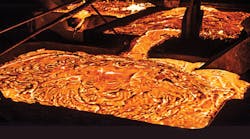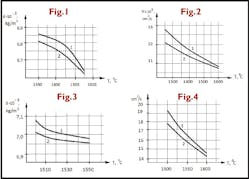Application of an electric field in the process of modification of casting alloys leads to an essential change in their mechanical properties1,2. For complete realization of the effect of the interaction of the electric field with metal alloy, modification particles, and the resulting crystal seeds, it is necessary to define the main impact factors of this physical process.
Regarding the application of electric field on liquid alloys at the point of modification, one can identify five factors that impact the mechanical properties of the alloy:
1. The Joule heat in the metal alloy, which appears due to the electric current that passes through the melt, which in turn arises due to electric field.
2. The influence of the current carriers accelerated by the outer electric field on the pre-crystal seeds of alloy, which appears in the molten metal under the influence of a modifier.
3. The impact of an additional energy of an oscillating process in the current carriers on the growth of pre-crystal seeds and crystal seeds in alloy.
4. The change in the value of the electric charge of the double electric layers, which appears between the pre-crystal seeds, crystal seeds, dissolving particles of the modifier, and the molten metal under the influence of electric field.
5. Arising from the process of electro coagulation of non-metallic particles in the liquid alloy under the influence of electric current passing through the melt of the modifying alloy.
The impact of the first factor is reduced due to the intensification of the convective flows and acceleration of the processes of mass transfer arising due to Joule heat. This leads to the uniform distribution of chemical elements, which constitute the modifier in the volume of the melt. Besides, the influence of the electric field and corresponding electric current in the melt increases the velocity of the process of dissolving the modifier, also increasing assimilation by the alloy[3].
The second factor, which develops when an electric field is imposed on the melt by inserting modifier particles, amounts to the energy transfer of current carriers accelerated by the current (electrons and atomic ions) to the atoms on the surface layer of the pre-crystal seeds of the melt[4]. The increased energy in this layer results in an increase of free energy, which in turn affects the critical radius of pre-crystal seeds in their transformation to the crystal seeds. Reducing the critical radius of pre-crystal seeds, which develops under the influence of the inserted modifier, increases the probability of their participation in the process of crystallization of alloy. Apart from that, the influence factor of the electric field in a similar manner can impact the pre-crystal seeds that are contained in the liquid alloy.
The third factor affects the increase in oscillation energy of pre-crystal seeds and crystal seeds by transferring to them the time-variable energy of electric field by current carriers. As revealed by special investigations of the effect of applying different electric fields in the process of modification the alloys, the greatest effect was obtained when a pulsing current was applied[5].
An effect of the fourth factor is observed under a contact of molten metal with pre-crystal seeds, crystal seeds, and dissolving particles of modifier, in which the level of Fermi energy differs from the level of Fermi energy for liquid alloy. The difference in the energies leads to the appearance of a double electric layer (DEL), which charge may vary under an influence of the outer field. Changes in the charge of DEL significantly influences the dynamics of the alloy crystallization process[6] and the formation of an ally structure.
The fifth factor of this process impacts the microstructure of molten metal under an electric current arising due to electric field. It is related to a coagulation phenomenon that takes place in liquid alloy[7] and acceleration of this process under an influence of electric coagulation, that is, by a possibility of association of several non-metallic particles in a uniform conglomerate. Such a unit with dimensions close to critical radius and due to activation processes taking place under the influence of an electric field allows participation in the process of alloy crystallization.
Achieving Liquid Alloys
The common effect of all these influence factors of electric fields in the process of modification should result in a change of state of liquid alloy. In order to determine these changes, certain investigations of structure-sensitive characteristics of initial alloys and alloys after processing by modified electric field were carried out. Measurements of densities and kinematic viscosity were made on samples of CCh25 cast gray iron and 40L cast steel. Figure 1 presents the results of radiation experiments in a pure argon atmosphere for the values of modified cast gray iron and modified cast iron processed by an electric field (modifier FC75 in the amount of 0.40% of the alloy mass). The data show that a change in density exists in the whole interval of temperatures for melt overheat at essential differences in the values of densities for samples of the cast iron processed by electric field in the course of modification (curve 1). (See Fig. 1.)
Measurements of kinematic viscosity for alloy samples were conducted by tortional fluctuations of alloys in a crucible, in a high-purity helium atmosphere. The viscosity values were based on dependencies found by E.G. Shvidkovsky. The viscosity measurements for the modified cast gray iron and the modified cast iron processed by electric field are shown in Fig. 2. From these it is clear that the values of viscosity of cast iron processed at the point of modification by electric field (curve 1) are higher than the values of viscosity of the original modified gray iron at all temperatures of an overheat of melt. (See Fig. 2.)
Finding values of density by the radiation method for samples of molten 40L steel (see Fig. 3) showed a density increase for steel processed at the point of modification (modifier FTi20 in the amount of 0.39% of alloy mass) by electric field (curve 1), as compared with the original modified steel (curve 2), across the temperature range.
Experiments to determine kinematic viscosity in samples of 40L steel showed an increase in the structurally sensitive characteristic of the alloy processed at the point of modification by electric field (see Fig. 4), as compared with initial steel (curve 2).
The results of the study of structure-sensitive characteristics of Fe-C alloys demonstrate the impact of electric field on the microstructure of modified gray iron and steel, which allows the development of an electro-microstructure effect. This effect appears due to several factors, which appear when an electric field is applied to the modified melt in the process of modification. As a result, changes will be observed in the conditions of dissolving of particles of modifier, appearing as pre-crystal seeds and crystal seeds in molten metal, which essentially alter the alloy crystallization process of alloy crystallization.
Thus, applying an electric field in the modification stage has a positive impact on the pre-crystal phase in the melt and on the alloy structure formation, which in turn improves the mechanical properties of alloys. It makes it possible to decrease metal consumption during casting and to improve economic indicators in the production of modified Fe-C alloys.
Dr. Minenko is an associate professor and head of the Resource Center for the Ministry of Industrial Engineering Education, Moscow. Contact him at [email protected]
References
1. Minenko G. N. “Features of influence of electrophysical fields at a stage of processes of extra oven processing of Fe-C of alloys”, Moulding of Ukraine, 2012, No. 10, pp. 14-16.
2. Minenko G. N. “Effect of influence of processing by the pulsing electric field on mechanical properties of cast steel,” Moulding of Ukraine, 2015, No. 2 (174), pp. 17- 20.
3. Minenko G. N. “Influence of processing of melt by electric field on processes of modifying of Fe-C alloys,” Foundry of Russia, 2014, No. 8, pp. 21-23.
4. Minenko G. N. “Features of the mechanism of impact of electric field on process of modifying of gray cast iron,” Moulding of Ukraine, 2014, No. 11 (171), pp. 7-9.
5. Minenko G. N., Smirnova Yu.A. “Physical model of impact of electric current on process of crystallization of an alloy,” Mechanical Engineering Metallurgy, 2009, No. 3, pp. 48-49.
6. Yershov G.S., Chernyakov of V.A. “Construction and properties of liquid and solid metals,” Metallurgy, 1978, p. 248.
7. Zhukov A.A., Snow R. L., Girshovich N. G., Davydov S. V. “About a submicroheterogeneous structure of liquid cast iron,” Foundry production, 1980, No. 6, pp. 3 - 4.










